Q&A – Ask Neil: July 14, 2022
(Please read these instructions carefully.)
I hope you’re enjoying this new Q&A format. We’re still making minor adjustments, but it’s getting better.
• Click here to post your question.
• After you submit your question, a new window will pop up giving you the address to which you can e-mail a photo to accompany your question. Clear, medium-resolution photos (not thumbnails, please).
• Please only post your question one time.
• One question per reader, please.
• Please use this only for posting questions – not for standard emails.
• Watch for your answer in the following week’s e-gardens.
• I choose those of greatest general interest. For example, plant IDs seldom make the cut.
• I must have your first name or initials.
• I must have your city or county. (Texas is a very large state.)
QUESTION 1
HOW MUCH IS TOO MUCH PRUNING FOR FREEZE DAMAGE?
Question: You have said a lot about trees that were damaged by the February 2021 freeze. I have trimmed some of the damage out of our tree, but if I cut all of it out, I feel like it would be the equivalent of topping it. Advice? Will it keep growing up at this point? Laura V., Glen Rose.
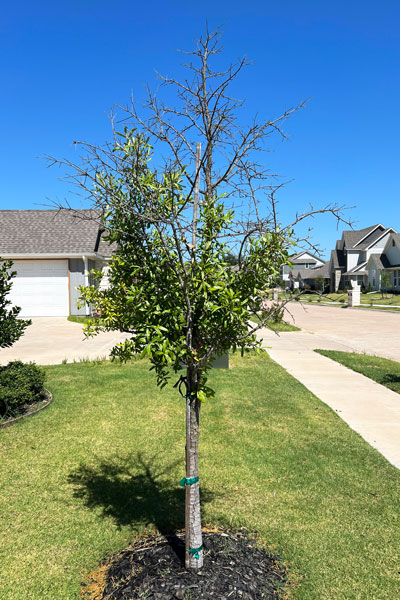
Answer: In most cases I’ve been talking about trees with much larger dead limbs – branches that could seriously hurt a person or ruin a car or rooftop were they to break and fall to the ground. But let’s speak to your tree. Wood that is dead is not going to come back to life. If you leave it there it will cause decay down into the living portions of your tree and you will very likely lose the entire tree. But it’s totally up to you. If it were my tree, I wouldn’t want to have all that dead brush standing out atop the plant. I would want to prune it out so that I could start reshaping what is left. I’ve zoomed in on the trunk of your tree and I see a lot of vertical cracks (radial shakes), and I’m not convinced that you’ve seen all the dieback you’re going to see. More of the bark may be getting ready to separate. You may end up deciding just to start over with a vigorous new tree. Please do keep that in mind as a possibility. Last year was really rough on many live oaks.
QUESTION 2
WHY ARE BRANCHES IN CRAPE MYRTLE DEAD?
Question: Why do I have dead branches in my crape myrtle? Is there anything I should do, or should I just trim out the dead branches? Wanda F., Desoto.
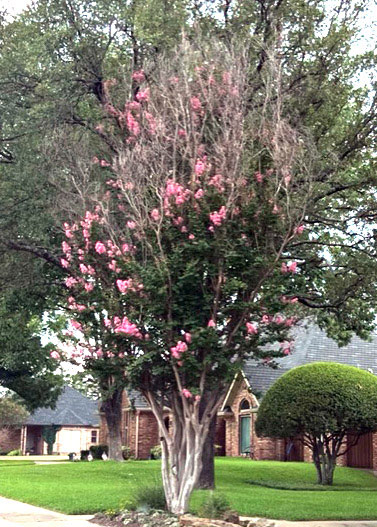
Answer: This is also damage done by the extreme cold of February 2021. It’s about halfway between where I would recommend cutting a crape myrtle back to the ground and retraining the vigorous sprouts that would come up versus carefully removing all the dead wood and reshaping the healthy growth. Since so much time has passed, I’d probably opt for the latter. In case you ever need to start over with the plant, however, here is a roadmap of how to do it from the website of our Crape Myrtle Trails of McKinney. I wrote all of this, so it’s easier just to link you over to it than to write it again. Scroll to the bottom of the page. https://crapemyrtletrails.org/basic-care/#pruning
QUESTION 3
DO I TRIM VITEX AFTER IT BLOOMS?
Question: I have two vitex bushes that have bloomed once. Should I cut off all the ends of the branches or do they bloom from the same ends? Paula W., Montague County.
Answer: If the plants are in any way misshapen by erratic spring growth, prune to correct that. Gardeners in South Texas often trim their vitexes back immediately after they finish blooming so that they’ll get a rush of regrowth and hopefully a second round of blooms in late summer/early fall. You can try that in Montague County, although you’re very far north to have time for those flowers and you’ve waited perhaps too long this year to try it.
QUESTION 4
WHY ARE PEACHES SMALL?
Question: I’ve always thinned my peach crop while the trees are blooming and I’ve always had an excellent crop. This year the fruit have stayed small. Did I do something wrong? Kat J., Tarrant County.
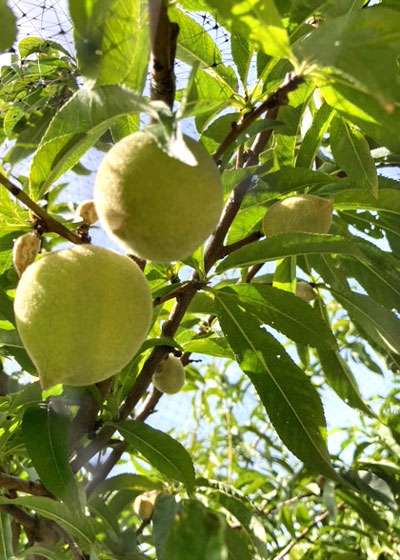
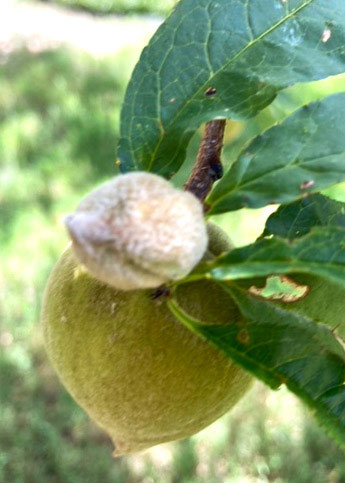
Answer: You want to thin your peaches when they are marble-sized so that they are 5 to 6 inches apart on the branches. I suspect, however, that your trees haven’t been getting enough water and the fruit hasn’t filled out very well as a result.
QUESTION 5
WHAT IS WHITE ASH IN SOIL – THAT’S KILLING SALVIA?
Question: (Second time I’ve posted question.) What is the white powdery ash that I find is killing my salvia plants? They’re in huge planters with potting soil and gravel for drainage. They’re watered once a week. Other salvias in the yard look fine. Laura P., San Antonio.
Answer: I’ll give your question a try, although it did not get posted into the box prior to this week. A photo of the “powdery ash” certainly would have helped. I can only guess that it was either fine pieces of perlite or a saprophytic fungus of some sort. However, it’s important to note that neither of those is harmful to salvias or other plants. I’m concerned that your watering only one time per week might not be nearly enough. Container gardens dry out much more quickly than the same plants will in the ground. For future reference as you’re mixing potting soils, gravel doesn’t do anything to improve drainage. It just takes up space. The example I always give is of a slow-draining bathtub. Throwing gravel in the tub doesn’t speed up the draining.
QUESTION 6
HOW CAN I STOP SQUIRRELS FROM CHEWING BARK? HOW CAN I SAVE THESE TREES?
Question: Squirrels have been chewing the bark off large limbs of my Japanese maple and one of my elm trees. How can I discourage that, and what can I do to help the trees recover? Dennis S., Arlington.

Answer: Squirrels are sharpening their teeth as they do this. Like our fingernails, their teeth are growing all the time. As for the bark, when it is lost halfway or farther around the trunk or a limb, that part of the plant will die from that point out. Other than keeping the squirrel away from the damaged plant entirely, there aren’t any horticultural heroics that will help the affected portions heal any faster. To repel squirrels, you might try the product called Tree Tanglefoot. You apply it with a putty knife. It’s sticky and animals don’t like to get their feet in it.
QUESTION 7
WHY IS SIOUX CRAPE MYRTLE DROPPING OUTER LEAVES?
Question: My Sioux crape myrtle has started dropping its outer-most leaves. The first round of flowers didn’t hold very long. What might have caused all of that? Sylvia S., Frisco.
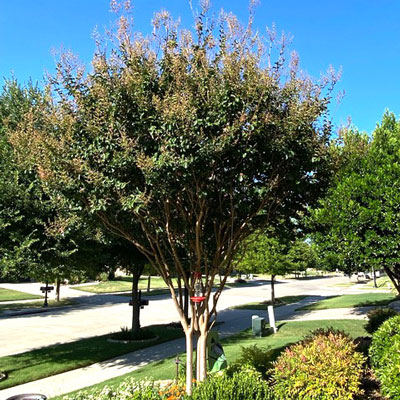
Answer: Unlike Wanda’s crape myrtle (above), I see no signs of freeze damage with your crape myrtle. However, the quick drop of flowers and shedding of leaves are both due to the onset of really hot, dry weather. I can tell from the rest of your photo that you’re taking good care of your plantings, but the weather has been so hot and humidities have been so low that this behavior is the plant’s normal response. Just keep doing what you’ve been doing. It will be fine.
QUESTION 8
CAN PENCIL CACTUS BE CUT WAY BACK TO PREVENT TIPPING OVER?
Question: I brought my pencil cactus into the house to protect it from freezing weather. It is still indoors, but now it’s 10 ft. tall. Can I cut it way back to keep it from tipping over? I’m having to tie it to a column to keep it upright. Can I plant the cutting? Gary O., Boerne.
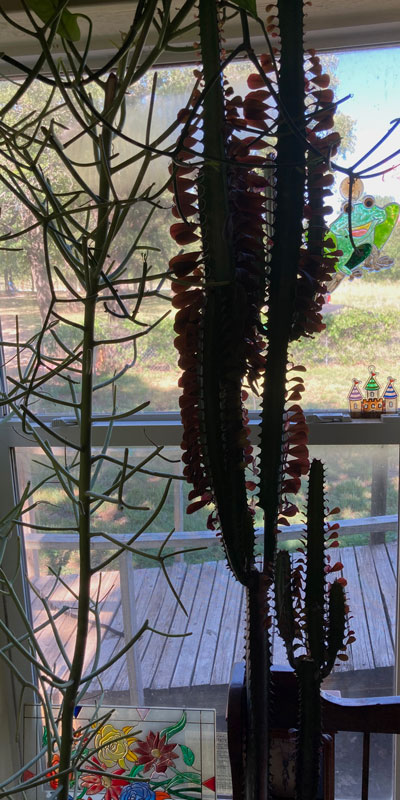
Answer: Pencil cactus is actually in the genus Euphorbia, making it a sister plant to poinsettias. Not a cactus at all.
It’s the plant in the left in the photo. Another Euphorbia is on the right. It’s another plant that looks like a cactus, but neither is.
(You did not shoot the photo I’ve put with your question. – it’s from Ken C. in Montague. He wanted an ID, which I normally don’t do here. However, I thought I could put his photo to work with your question and accomplish two things at the same time. Not bad for an old guy who graduated from an ag school!)
Yes. You can trim your pencil plant back by half or so. Do so outside on the patio over newspapers. It will “bleed” a sticky white latex sap profusely. You don’t want that drip on your floors, plus it’s very caustic should a child or pet get it in his or her mouth or nostrils. When you take cuttings to root they should be short (4-5 inches). Allow them to dry for a day or two, making sure to keep the bottom ends together so that you’ll be able to stick them into their pots correctly. Root them in a potting mix consisting of half peat moss and half horticultural perlite that you can keep moist. They root very easily.
QUESTION 9
WHAT HAPPENED TO MY PLANTS?
Question: I’ve had these plants for many years. They were healthy and spread. Then, all of a sudden, they got small holes. My yard person sprayed with an insecticide. Then he dusted them two weeks later. They wilted two days later and now appear to be dying. What gives? Denise C., East Fort Worth.
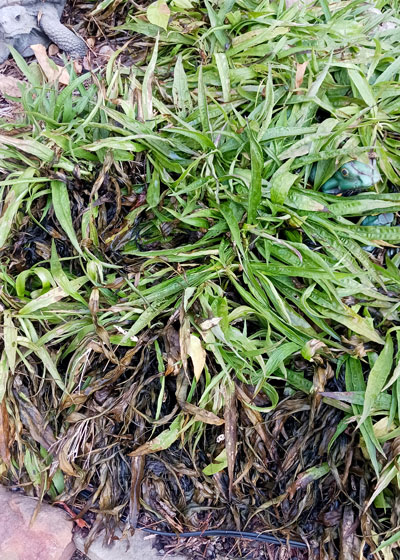
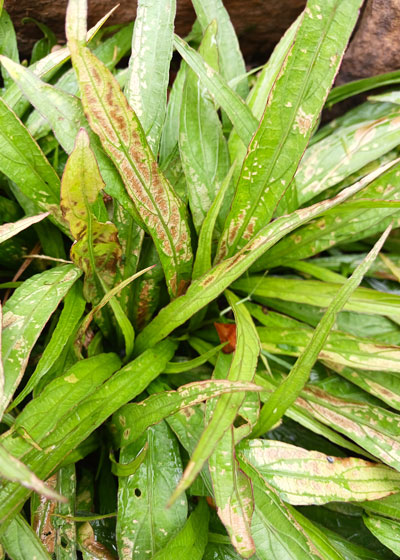
Answer: I think these are Ruellias, Mexican petunias. I’ve grown them for 40 years, so I’m very familiar with them. I’ve spent half an hour trying to determine what the problem might be, and I’ve come up without an answer. I checked for spider mites (my first guess) but I see no online reference to their being susceptible and my plants have never had them. I could only see minor mottling on the leaves. I found no reference to any type of diseases. I’m going to suggest that you run it through Google using key words “University” and words like “plant pathology” and “entomology” to go along with “Ruellia.” You could also have the Texas Plant Disease Clinic at Texas A&M run a culture on a sample. There would be a charge for it, Details are on their website.
QUESTION 10
HOW CAN I SAVE MY CEDAR ELM?
Question: The bark around the base of this cedar elm is cracked and separating. The canopy is a little thinner and less green as well. Any suggestions on what I can do to save it? William C., Fort Worth.

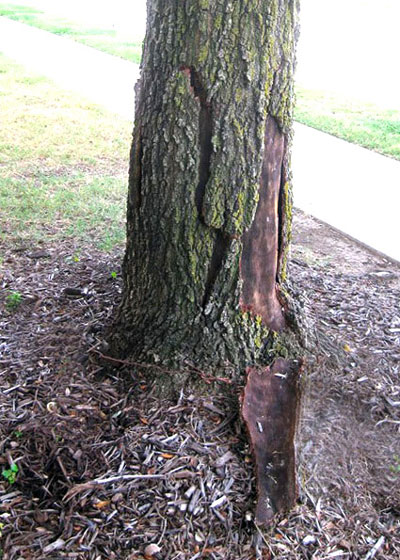
Answer: There is nothing you can do at this point. The tree is either going to heal itself or it’s going to die trying. A certified arborist might be able to see some type of tweaking that could be done if he or she could look at it on site, but without professional guidance most of us would probably do more harm than good. This may be yet another example of freeze damage from February 2021. Cedar elms, for the most part, were not hurt.
QUESTION 11
HOW CAN I STOP ANTS FROM CLIMBING MY OKRA STALKS, BUILDING MUD CLUSTERS?
Question: I have a row of okra planted in a raised bed alongside our tomatoes. I’ve never had ants crawl up the stems of okra and build mud “huts” as their colonies. How do I stop that? Salli S., Cross Roads in Denton County.
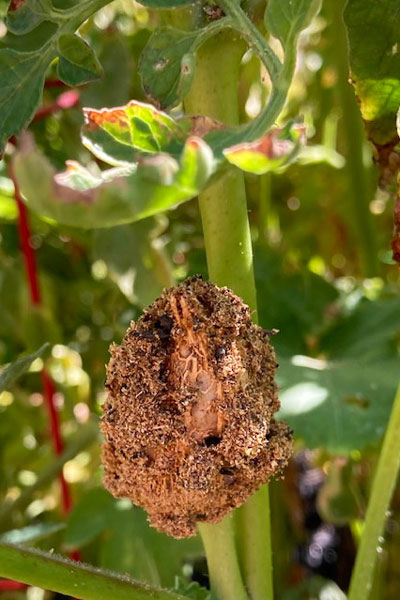
Answer: Those may very well be fire ants. They are quite fond of the oils that are secreted from okra stems and blooms when they feed on them, and these deformities are the resulting abnormal growths that develop. Try using a fire ant bait around the perimeter of your garden, and you might apply a bit of sticky Tanglefoot to the base of each okra plant to make it difficult for the ants to climb the stalks. I hasten to add that there is a great deal of information on this online, much of it in amateur blogs. You might find other useful suggestions there.
QUESTION 12
WHAT HAS HAPPENED TO BUTTERFLY BUSHES?
Question: I have several Pugster blue butterfly bushes whose leaves have shriveled and turned brown. They then turn crisp and die. I’ve tried less water and more water and neither seems to help. Any suggestions on how I can avoid losing them completely? Kim R., North Richland Hills.
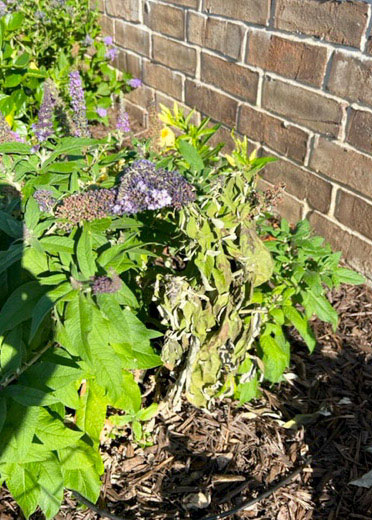
Answer: I can’t tell from this photo so I’m just going to have to make some assumptions. Butterfly bushes are normally easy to grow, so don’t give up on trying them. However, these plants may have gotten too dry at some point. Then trying more (or less) water in an effort to correct an unknown problem wouldn’t have helped. Now they look like they’re starving for iron and or nitrogen, probably because of all the damage they have suffered. If they were my plants I’d probably remove them and replace them this fall with zinnias, marigolds or some other colorful annuals, then rework the bed and start fresh next spring. Rethink how you’ll prepare the soil and subsequently care for the plants.
QUESTION 13
SHOULD THIS LIMB BE REMOVED?
Question: One of our live oak trees appears to be losing bark off one of its branches. The wood underneath looks healthy. Should we remove this one branch? This seems to be the only branch that’s affected. Katherine V., McLennan Co.
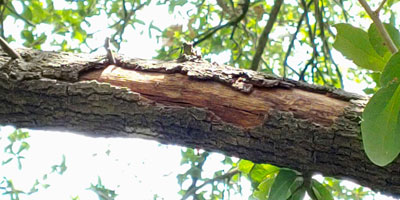
Answer: Watch the leaves on that particular branch. If they start to turn brown and die, remove the branch. If it can successfully heal around the wound, let it do so. Let it determine its own fate.
QUESTION 14
CAN ADMIRATION BARBERRY BE SAVED?
Question: My new Admiration barberries have struggled over the past few weeks. I give them a thorough watering with my bubbler attachment every four days. When they started looking really rough, I applied Imidacloprid spray thinking it might be insect-related. Suggestions? Jim S., Arlington.
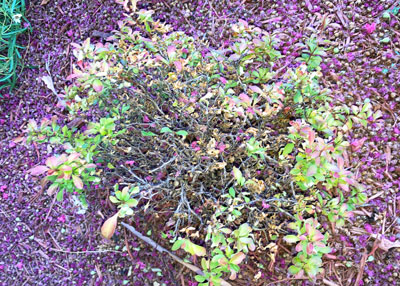
Answer: This answer will be directed at DFW and westward where light intensities and temperatures go up and humidities go down. Barberries in general are not happy with hot, dry Texas summer weather. Think about how seldom you see them growing successfully in landscapes within 25 miles of your house. That alone should say a lot. They can be grown in specialized settings where they get perfect soil, regular care and average weather (not record-setting like we’ve been having this year). Add to that the fact that the more red or yellow variegation you add to their leaves the more difficult it is for them to thrive. Folks in East Texas will have better luck with them, and the best luck of all would be when they’re planted on the east side of a house for morning sun and afternoon shade. Finally, just to have said it: this is not about insects or diseases. It’s about climate.
